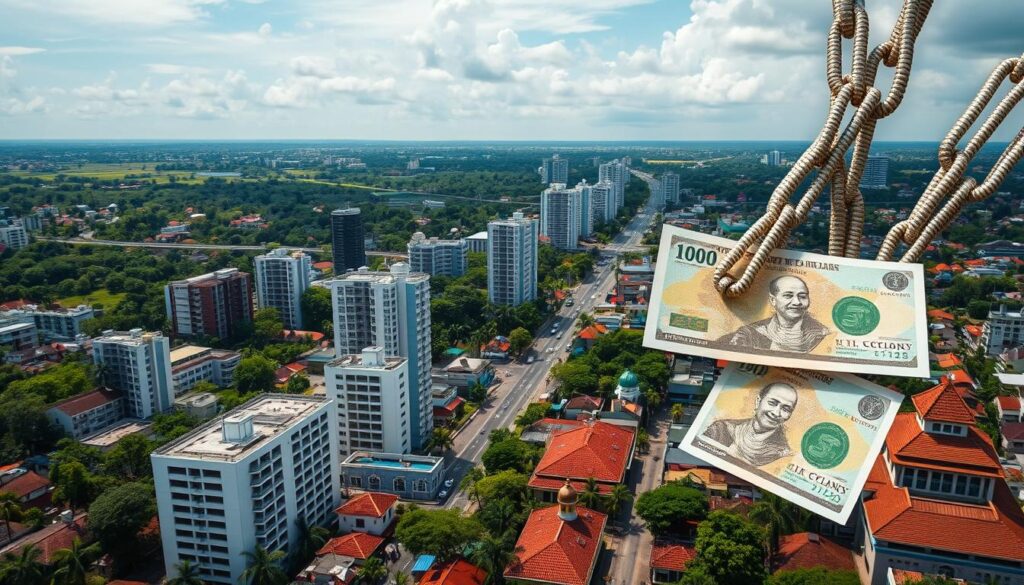Sri Lanka’s External Debt Reaches USD 37.5 Billion
Sri Lanka’s external debt hit USD 37.5 billion in June 2024. The Ministry of Finance’s Mid-Year Fiscal Position Report revealed this alarming figure. The country struggles with economic challenges while working on recovery and reforms.

The report shows Sri Lanka’s dire economic state. It highlights the urgent need for fiscal consolidation and debt management. The government faces tough challenges with low foreign currency reserves and looming debt payments.
The report breaks down Sri Lanka’s external debt in detail. From January to August 2021, foreign financing commitments reached USD 37.5 billion. This huge debt burden poses significant obstacles to long-term economic growth and development.
Debt Crisis and Economic Turmoil
Sri Lanka faces a severe debt crisis, with external debt reaching USD 37.5 billion. Foreign currency reserves are depleted, and the country has defaulted. This has left Sri Lanka in a precarious financial position.
The debt crisis is part of a larger trend in the Asia-Pacific region. Government debt among Asian Development Bank members has increased significantly. South Asian countries have been hit the hardest.
Sovereign Default and Foreign Currency Reserves
Sri Lanka is struggling to meet its financial obligations. The country’s external debt service at risk is $598 billion from 2021-2025. Private creditors hold 52% of the debt at risk, totaling $311 billion.
Fiscal Consolidation and Austerity Measures
The Sri Lankan government is implementing fiscal consolidation and austerity measures. These aim to reduce spending, increase revenue, and improve the country’s fiscal position. However, these measures have led to increased hardships for the population.
The global environment poses challenges to Sri Lanka’s efforts to restore public finances. With obstacles to growth and rising borrowing costs, economic recovery remains difficult. The country faces an uphill battle in its quest for stability.
Sri Lanka’s External Debt Reaches USD 37.5 Billion as of June 2024
Sri Lanka’s external debt hit USD 37.5 billion in June 2024. The Mid-Year Fiscal Position Report revealed this alarming figure. It highlights the nation’s economic challenges and the need for better debt management.
Mid-Year Fiscal Position Report Findings
The report analyzes Sri Lanka’s fiscal health in detail. It focuses on the country’s external debt obligations. The report also examines the debt’s impact on the economy.
Debt Servicing Payments: Principal and Interest Breakdown
Debt servicing payments totaled USD 503 million from January to June. This includes USD 275.1 million in principal repayments. Interest payments accounted for USD 227.9 million.
These figures show the heavy burden of debt servicing. It strains the nation’s financial resources significantly. The government must address this issue promptly.
Rising external debt threatens Sri Lanka’s economic stability and growth. Effective debt management strategies are crucial. These include debt restructuring, fiscal consolidation, and attracting foreign investment.
Interim Debt Standstill Policy
Sri Lanka introduced an interim debt standstill policy on April 12, 2022. This move aimed to tackle the growing external debt crisis. The policy temporarily halted repayments to bilateral and commercial creditors.
By June 2024, Sri Lanka’s external debt hit USD 37.5 billion. The repayment pause led to USD 5.67 billion in unpaid principal. Unpaid interest totaled USD 2.527 billion.
Temporary Suspension of Repayments to Bilateral and Commercial Creditors
The policy affects loans from foreign governments and commercial lenders. It covers banks and bondholders too. This pause aims to give Sri Lanka time to stabilize its economy.
The country now has a chance to negotiate a comprehensive debt restructuring plan. This breathing space is crucial for finding long-term solutions.
Accumulation of Unpaid Principal and Interest
The policy has provided temporary relief but also caused a buildup of unpaid amounts. In early 2024, debt service payments reached USD 503 million. This included USD 275.1 million in principal and USD 227.9 million in interest.
These growing arrears highlight the urgent need for a lasting solution. Sri Lanka must address its debt crisis quickly to avoid further economic strain.
Debt Restructuring and International Monetary Fund (IMF) Involvement
Sri Lanka faces a mounting debt crisis. The government is negotiating debt restructuring and seeking IMF assistance. On March 20, 2023, the IMF approved a 48-month Extended Fund Facility (EFF) arrangement.
The EFF totals SDR 2.286 billion (about $3.0 billion). It aims to support Sri Lanka’s efforts to stabilize its economy. The IMF’s involvement provides financial support and guidance for necessary reforms.
The immediate disbursement was SDR 254 million (around $333 million). A policy-based loan for the Economic Stabilization Program offers additional budget support. This support depends on Sri Lanka completing prior actions under the IMF EFF.
Sri Lanka’s debt crisis results from recurring fiscal and current account deficits. These led to unsustainable public debt levels. Policy missteps and external shocks worsened the country’s economic vulnerabilities.
A 2019 change in government administration further weakened public finances. Significant tax cuts were implemented. Reform measures were suspended. These actions deepened the crisis.
Comprehensive debt restructuring is vital for Sri Lanka’s recovery. The global community must increase debt relief efforts. This action can prevent a worsening development crisis in Sri Lanka and other struggling economies.
A new international debt restructuring initiative is proposed. It involves comprehensive restructuring and write-offs. This approach could help countries return to growth and financial markets faster.


